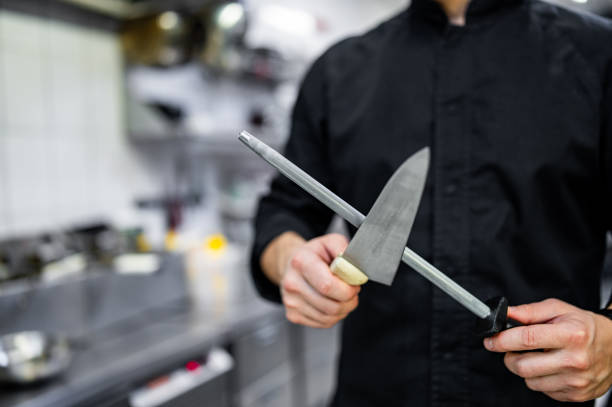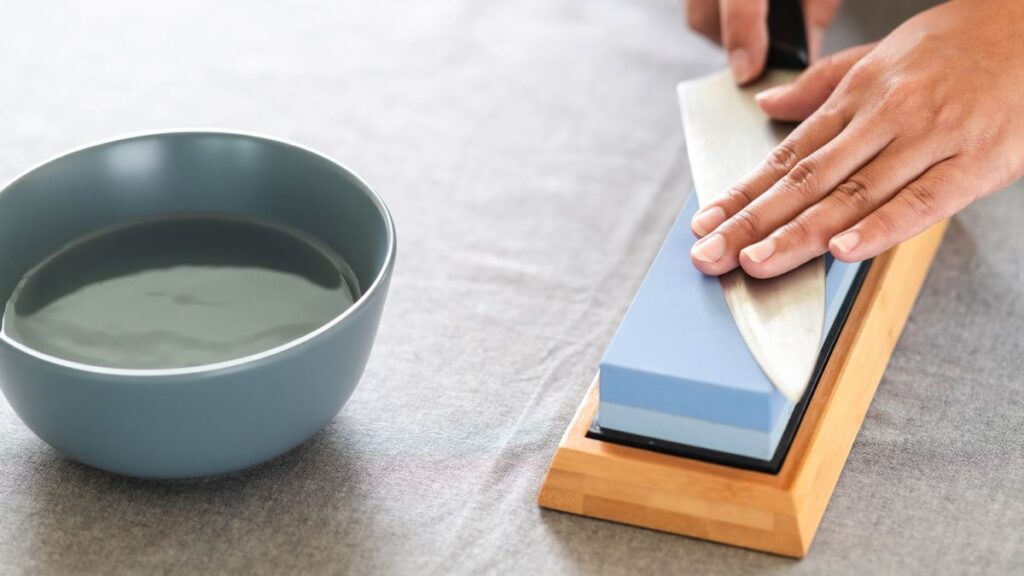The Ultimate Guide to Knife Sharpening at Home (2025): How to Sharpen Kitchen Knives Like a Pro

Did you know that a dull knife is actually more dangerous than a sharpen knife? It’s true! Through my experience working as a chef for 15 years I have seen numerous accidents occur from using dull knives on vegetables. But here’s the good news: You can easily maintain sharp knives in your home kitchen. I will explain all my knife sharpening knowledge including beginner and expert methods to enhance your kitchen work.
Why Sharp Knives Matter
A sharp knife helps you cook safely while working faster and having more fun during your kitchen tasks. When you use a properly sharpened knife, you’ll notice an immediate difference: vegetables slice cleanly instead of crushing, meats cut precisely rather than tearing, and detailed work becomes effortless instead of frustrating.
The benefits of maintaining sharp knives include:
- Improved safety through controlled, predictable cuts
- Better preservation of food texture and appearance
- Reduced hand fatigue during food preparation
- Extended knife lifespan through proper maintenance
More enjoyable cooking experience overall
Understanding Knife Sharpening Basics
Before learning the specific techniques, you should grasp the basic difference between honing and sharpening. Sharpening cuts away metal to form a new edge while honing fixes the current edge alignment on your knife. Think of it this way: Honing is like brushing your hair while sharpening is like going to the barber to cut your hair. Every time you use your knife the extremely thin edge starts folding or getting out of shape. Honing your knife regularly extends its straight edge until the blade needs actual sharpening to regain its cutting effectiveness.

Regular use of your knife can bend or twist its super-thin edge. Regular honing maintains the sharpness but you will need to sharpen the blade when the edge becomes too dull to cut effectively.
Signs your knife needs sharpening:
- It struggles to slice through tomato skin
- Paper “catches” instead of cutting cleanly when testing the blade
- You find yourself applying more pressure while cutting
- The knife slides off food instead of biting into it
- You can see reflected light along the cutting edge
Essential Tools for Knife Sharpening
To sharpen knives effectively, you’ll need the right tools. Here’s what I recommend:
Primary Sharpening Tools:
1.Whetstones (Water Stones):

- A 1000 grit stone for regular sharpening
- A 4000-6000 grit stone for finishing
- Optional: 400 grit stone for repair work
2.Honing Rod:

- Smooth steel or ceramic for regular maintenance
- 12″ length works well for most kitchen knives
3.Additional Equipment:
- Stone holder or non-slip mat
- Angle guide (for beginners)
- Clean cloths for wiping blades
- Container for water (if using water stones)
Step-by-Step Sharpening Process
Let’s break down the sharpening process into manageable steps:
1. Preparation
First, soak your Waterstone for 10-15 minutes (if using). Position your stone in a holder or on a non-slip surface. Have a container of water nearby for maintaining stone moisture.
2. Finding the Right Angle
Most kitchen knives are sharpened at a 20-degree angle. To find this:
- Hold the knife perpendicular to the stone (90 degrees)
- Tilt halfway to the stone (45 degrees)
- Tilt halfway again (22.5 degrees)
- This is very close to your target angle
3. The Sharpening Technique
- Start with the coarser stone (1000 grit)
- Beginning at the heel of the blade:
- Place the knife at the correct angle
- Apply moderate pressure
- Draw the blade across the stone as if trying to slice a thin layer off the top
- Maintain a consistent angle throughout the stroke
- Repeat this motion 5-10 times on each side
- Check for a burr (a small wire edge) on the opposite side
- Once you feel the burr along the entire edge, switch to the finishing stone
4. Finishing
- Switch to your higher grit stone
- Repeat the same motion but with lighter pressure
- Reduce pressure with each stroke
- Finish with extremely light strokes to refine the edge
Maintenance and Care
Maintaining your newly sharpened knife is crucial for longevity:
1.Daily Care:
- Always hand wash and dry immediately after use
- Use a honing rod before each use
- Store in a knife block or magnetic strip
2.Cutting Surface:
- Use only wood or soft plastic cutting boards
- Avoid glass, marble, or granite surfaces
- Keep boards clean and free of deep cuts
3.Regular Maintenance:
- Hone before each use
- Sharpen every 3-6 months for home use
- Clean stones after use and store dry
Troubleshooting Common Issues
Even experienced cooks encounter sharpening challenges. Here’s how to address common problems:
Uneven Edge
If you notice the knife isn’t cutting evenly:
- Mark the edge with a marker
- Sharpen until the marker is completely removed
- Check that you’re maintaining consistent angle and pressure
Chips or Nicks
For minor damage:
- Start with a coarser stone (400 grit)
- Focus extra strokes on the damaged area
- Progress through finer grits as normal
Rolling Edge
If the edge rolls quickly after sharpening:
- You may be using too acute an angle
- Try increasing the sharpening angle slightly
- Ensure you’re not applying too much pressure while cutting
Conclusion
Learning to sharpen knives takes time and practice. Start with essential knowledge and continue practicing until you naturally understand the steps. In cooking you will enjoy safer and better results by dedicating time to maintain your tools sharp. Ready to get started? Practice first with your go-to kitchen knife and stay committed to this new skill even when you’re not totally successful at the beginning. Through consistent practice you will build automatic knife sharpening abilities that can maintain your entire knife collection professionally. Have questions about knife sharpening? Feel welcome to post your questions below and I will gladly support you through any challenges you meet. Happy sharpening!
